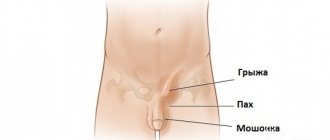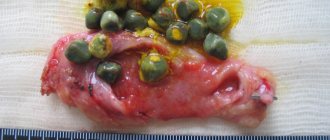Inguinal hernia in women: symptoms and treatment options
An inguinal hernia is a disease in which the abdominal organs protrude into the inguinal canal beyond the abdominal wall while maintaining the integrity of the covering membrane. Externally, the hernia looks like a spherical swelling in the groin area.
This pathology for women is the exception rather than the rule, since about 90% of people with this disease are men. The female body has a number of features that protect it from hernia. First of all, this is a small inguinal gap - the opening of the inguinal canal in women is much narrower than in men. The aponeurosis of the external oblique muscle is much stronger, and the bundles of collagen fibers bounding the superficial inguinal ring are more densely concentrated.
In addition, women do not have a spermatic cord in the inguinal canal (by the way, it is precisely because of its absence that representatives of the fairer sex never have oblique inguinal hernias), which weakens the resistance of the wall to pressure from the inside. Nevertheless, inguinal hernias still occur in women.
Causes of hernia
An inguinal hernia is considered as a pathological process. Protrusion of internal organs occurs for a number of reasons.
Producing factors:
- prolonged vomiting;
- complications during childbirth;
- abdominal injuries;
- increased pressure inside the abdominal cavity;
- severe cough that does not stop for a long time;
- work associated with heavy lifting;
- excess body weight.
Predisposing factors:
- genetic predisposition;
- weak muscular system due to congenital characteristics of the body;
- lack of physical activity;
- fragile body constitution.
Age also affects the occurrence of pathology. There are 2 periods in human life when the likelihood of developing a disease increases:
- Stage 1 - age from 12–24 months;
- Stage 2 - age over 40 years.
An inguinal hernia in childhood appears due to congenital characteristics of the musculoskeletal system. The causes of hernia in later life are producing factors.
Examination methods for diagnosis
Diagnosing an inguinal hernia is not difficult. By collecting a detailed history of the disease and life, and an objective examination, a preliminary diagnosis is made.
To clarify, additional examination methods .
- Laboratory tests (general analysis and blood biochemistry, liver tests, coagulogram, general urinalysis) - prescribed to identify the degree of severity, in preoperative preparation to assess possible risks during surgery;
- Ultrasound of the abdominal organs, pelvis, inguinal canal, scrotum - allows you to visualize the contents of the hernial sac, differentiate an inguinal hernia from other diseases, clarify the type, assess the condition of the inguinal canal and the organs involved;
- Herniography - an X-ray examination with contrast is performed for an internal inguinal hernia, when there are complaints of pain in the groin area, but there is no obvious protrusion;
- Irrigoscopy – X-ray contrast examination of the colon to determine its location;
- Cystography is an X-ray examination of the bladder with the introduction of a contrast agent, prescribed for suspected sliding inguinal hernia involving the urinary system;
- Computed tomography - allows you to accurately localize the hernial orifice, determine the contents of the hernial sac, and is performed in doubtful cases to verify the diagnosis.
The doctor who has diagnosed an inguinal hernia will tell you what to do next and select safe treatment with minimal risk of relapse, taking into account individual characteristics.
Effective Treatments
Easily reducible hernia contents give the false belief that the inguinal hernia has resolved on its own.
There are no conservative treatment options . An elastic bandage prevents strangulation, slows down the rate of progression of an inguinal hernia, surgical treatment completely neutralizes the pathological process, and reduces the risk of relapse to a minimum.
Incarceration with signs of an “acute” abdomen is a direct indication for emergency surgical care. The operation is performed as quickly as possible with minimal examination and preoperative preparation. Planned treatment of an inguinal hernia, the symptoms of which do not cause concern for the patient’s life, is carried out after a full examination.
Hernioplasty is performed using open access and laparoscopic methods .
The operation using the Lichtenstein method is a classic version of open repair, the “gold ” standard , which is effective for hernias of any size and location. Does not require general anesthesia. The protrusion is reduced without opening the hernial sac, after which a special mesh is installed to strengthen the structures of the inguinal canal. With this treatment, the risk of relapse is less than 1%. But in the first days after the operation, pain may be expressed; in the long term, chronic abdominal pain is sometimes bothersome.
A less invasive way to eliminate an inguinal hernia are laparoscopic techniques: transabdominal preperitoneal repair (TAPP), total extraperitoneal repair (TEP).
Access is made through three small punctures in the abdominal wall, which ensures quick recovery and minimal cosmetic defects. The operation is performed under general anesthesia using an endoscopic unit. An ideal correction option for a bilateral process. The intensity of pain after surgery is significantly lower.
Classification
Inguinal hernia in women is classified according to two criteria. This is the location of the hernial sac, as well as the degree of reducibility of the hernia. There is also a distinction between the formation of a bag on the left or on the right. The bilateral type is rare.
Depending on the location, the following types are distinguished:
- Direct - protrusion occurs through the internal inguinal opening (internal inguinal fossa).
- Oblique - the contents of the sac exit through the external inguinal fossa. This type is the most common.
- External subvesical - here the protrusion of the sac passes through the supravesical fossa.
Based on the degree of reducibility of the hernial sac, a distinction is made between hernias that are easily reducible (this can be achieved by taking a supine position), as well as hernias that are difficult to reduce. It is difficult for the patient to independently achieve straightening of the hernial sac even in a lying position.
Congenital hernias of the inguinal region
The development of a congenital inguinal hernia in a boy is associated with a specific anatomical anomaly that occurs in the prenatal period, during the formation of the testicles. The testicles in the human embryo initially develop inside the abdominal cavity. The abdominal cavity itself is lined from the inside with peritoneum - a thin and fairly simple serous tissue. Future testicles are also formed inside the peritoneum, where they remain until the third to fifth month of pregnancy. During the fifth month of intrauterine development, the testicles gradually begin to descend: they enter the inguinal canal and pass along it, carrying with them the sheets of peritoneum that envelop them. Movement along the inguinal canal continues until the seventh month of intrauterine development of the fetus. By the time of birth, the testicles descend into the scrotum, forming the so-called vaginal process of the peritoneum - a pocket of serous tissue that communicates with the abdominal cavity. However, then this canal first collapses, and then completely overgrows, and communication with the abdominal cavity stops.
For one reason or another (which can be very different - from hereditary characteristics of the formation and descent of the testicles to the impact of unfavorable external factors on the body of the expectant mother or an already born baby), the process of fusion of the vaginal process of the peritoneum may be disrupted. If there are open cavities along its length, cysts of the spermatic cord may subsequently form. If the peritoneal pocket remains unclosed along its entire length, all the prerequisites are created for the subsequent formation of an inguinal hernia. With the slightest increase in intra-abdominal pressure - and in a newborn baby it increases even when crying - loops of intestine or strands of omentum may fall into the pocket. As a rule, the first manifestations of a congenital hernia, given its origin, occur precisely in childhood. It is extremely rare that the manifestation of a congenital hernia occurs in adults, however, such a development of events is also possible and should be remembered.
The vast majority of congenital hernias occur in boys. However, there is a possibility of their formation in girls. The process as a whole is similar to that in the developing male body, but instead of the testicles, the “conductor” of the peritoneal process is the uterus, fallopian tubes and ovaries. The fact is that initially the rudiment of the uterus in the body of a female fetus is laid inside the abdominal cavity, and much higher than its subsequent location. During intrauterine development, the uterus gradually moves into the pelvic cavity - the place where it will be located in the future. In this case, the uterus also carries along a layer of peritoneum, forming a pocket, which can subsequently also cause the development of a congenital inguinal hernia.
Symptoms
The protrusion can have different sizes - from barely noticeable to a very large formation that causes discomfort when walking. The size of the protrusion has little effect on both the intensity of pain and the risk of developing strangulation. In uncomplicated small-sized formations, the protrusion occurs in a standing position and with abdominal tension, and with relaxation and in a lying position, the hernia spontaneously reduces.
The main signs of an inguinal hernia in women are pain and the presence of a mass formation in the groin. The severity of symptoms depends on the stage of the hernia (beginning or mature):
| Formed | Beginning hernia |
| Patients present clear complaints, from which a doctor of any specialty can easily make a diagnosis. | Feedback from women about symptoms is vague, and most often comes down to a description of periodic discomfort. |
| Gradually, the pain becomes more intense, occurs at rest or torments patients constantly - sometimes intensifying, sometimes subsiding. | Pain in the groin area is absent or slightly bothers women, occurring only from time to time (during intense physical activity, after a long stay in a standing position). |
| A mass formation in the groin in the form of a protrusion in the inguinal fold, above the pubis, in the area of the labia majora. | No space-occupying formations are detected during external examination. |
Symptoms of an inguinal hernia in women also depend on which organ emerges through the inguinal canal. Thus, when the loops of the large intestine come out, chronic constipation develops, and when the ovary, fallopian tube or uterus comes out, women are bothered by pain in the lower abdomen, radiating to the lower back or sacrum, which sharply intensifies during menstruation.
Symptoms of hernia in women
Women are not always able to independently detect an inguinal hernia, since its symptoms are often erased. This is due to the small size of the protrusion. When the pain intensifies during the next menstrual cycle, this indicates that the genitals have entered the hernial sac.
Among the main symptoms of a formed hernia:
- The appearance of a protrusion in the groin area, having a tumor-like shape.
- The occurrence of pain in the lower abdomen. Sometimes the pain radiates to the lumbar region and the sacrum area.
- The pain intensifies with sneezing and coughing, as well as with physical activity.
- Women experience symptoms characteristic of impaired digestion - flatulence, diarrhea or constipation.
Symptoms of hernia in women, depending on the type:
Strangulated hernia
Strangulation is considered the most dangerous complication. Under the influence of certain reasons, the contents of the sac are strangled in the hernial orifice. This process leads to poor circulation and death of healthy tissue.
Signs of infringement include:
- strong pain;
- inability to straighten the contents of the bag;
- if the uterus is pinched, pain can cause loss of consciousness;
- nausea, malaise, vomiting;
- The temperature often rises.
If you notice such symptoms, you should immediately consult a doctor. A timely reaction and competent medical care will help avoid serious consequences in the future.
Complications of groin hernias in women
Naturally, a formed inguinal hernia causes a woman some discomfort and also represents a cosmetic defect. However, these are far from the most serious complications that protrusion can provoke.
- Inflammatory process. The development of inflammation inside the hernial sac occurs infrequently, but can significantly affect a woman’s health. Within the hernia, appendicitis may begin to develop, inflammation of the genital organs, and colitis may develop. Depending on the severity of the inflammatory process, body temperature will rise and general well-being will be disrupted. However, even minor inflammation can provoke the formation of adhesions, which, in turn, lead to the hernia becoming irreducible. In addition, emergency surgery may be required if acute inflammation develops. Its signs: a significant increase in body temperature, the appearance of vomiting and nausea, severe pain.
- Fecal impaction. When a section of the colon gets into the hernial sac, it can cause intestinal obstruction. This process develops gradually as feces accumulate in the sunken area. As a result, the woman suffers from digestive disorders. If this pathology is left untreated, it can lead to intestinal death. This occurs due to insufficient blood supply. Most often, this process affects older people with excess body weight. As for treatment, massage or taking laxatives can temporarily alleviate the patient’s condition. However, to fully eliminate the stagnant process, surgical intervention is necessary.
- Strangulated hernia. This is one of the most dangerous complications, as it occurs unexpectedly and abruptly for the patient. The entire contents of the hernial sac are compressed in the area of the excretory opening. There is a sharp disruption of blood circulation and compression of nerve fibers. According to statistics, up to 15% of patients are susceptible to a similar process.
The following symptoms indicate infringement:
- Inability to reduce a protrusion that was previously freely adjustable.
- The occurrence of severe pain in the groin area. The pain spreads to the entire abdominal cavity.
- The bag itself becomes dense, and tension is felt in it.
- The patient experiences vomiting and nausea.
- In some cases, a rise in body temperature is observed.
Diagnostics
At the appointment, the gynecologist or surgeon will conduct an external examination and palpation, and will also try to correct the hernia. He will collect a complete history, which will allow you to find out what led to the development of the disease.
To make an accurate diagnosis, a patient with a suspected inguinal hernia will be prescribed one or more additional tests, such as:
- Ultrasound of the pelvic and abdominal organs, including hernial protrusion. This is necessary to determine the contents of the hernial sac.
- Herniography is an x-ray method that helps to see the course of the hernial canal and find out what organs are located in it.
- Irrigoscopy is another X-ray technique. When used, contrast is used to determine the location of the intestines.
- Bimanual examination. A diagnostic method by manual examination through the vagina and intestines is necessary when the genitals of a sick woman enter the hernial sac.
General information
Inguinal hernias are among the most common abdominal wall hernias. The only effective treatment is surgery. More than 20 million hernia repairs are performed annually worldwide.
Pathology is more often diagnosed in men than in women. This is due to anatomical differences in the inguinal canal. In men, it is shorter and wider, and is also less strengthened by muscle tissue and tendon layers.
Treatment of an inguinal hernia cannot be delayed. The pathology is like a time bomb, which can suddenly explode at any moment (complicated - pinched) and lead to the development of peritonitis (inflammation of the abdominal wall) and necrosis (death) of internal organs. A strangulated hernia is a direct threat to life! [1,2,3]
Treatment without surgery
First of all, pay special attention to the ineffectiveness of treatment with conservative methods! Exercises for an inguinal hernia, physiotherapy, compresses, bandages, and other methods can temporarily alleviate the condition, but will not cure the patient!
Time wasted can lead to complications, which will be mentioned later in the text. And, if an umbilical hernia can “go away” on its own, then this problem will not go away with an inguinal hernia - the patient will need surgery in any case.
Remember that today the vast majority of ailments can be perfectly treated, but only on the condition that the patient approaches treatment correctly and responsibly!
How to treat an inguinal hernia?
The main rule for treating inguinal hernia in women: surgery is the only effective method. Exercises, physiotherapy, compresses, bandages, and many other unscientific methods are not able to cure this disease.
- Tension hernioplasty. The method is based on the usual tightening of tissues and stitching them at the location of the hernial orifice. This is one of the most inexpensive, simple and old methods. In modern medicine, this method is rarely used, since its main disadvantage is a pronounced scar, long recovery, and frequent relapses.
- Tension-free hernioplasty. The method is based on strengthening the wall of the inguinal canal with synthetic materials. One of the variations, the Lichtenstein operation, has become the most common in most Russian clinics. The mesh prosthesis is sutured to the aponeurosis. The muscles are not injured, and the absence of tension reduces the risk of relapse to a minimum. Modern polypropylene mesh is not allergenic, does not dissolve and almost never causes infection. At the same time, the search for the “ideal” material for prosthetics continues. Wall suturing is possible through open and laparoscopic access. The latter has the advantages of low trauma and minimal cosmetic defects. But many experienced surgeons prefer to work through open incisions, considering them more effective and safer. In addition, laparoscopic access necessarily requires general anesthesia.
- Extraperitoneal endovidoscopic hernioplasty. The main feature of the method is extraperitoneal access during surgery. The prosthesis is installed under the skin without affecting the peritoneum. The main advantage of this method is the absence of adhesions in the abdominal cavity. The main disadvantage is the complexity of implementation. This method is essentially non-tension. Due to the anatomical features, treatment of an inguinal hernia in women requires less effort and time. Therefore, the number of unsuccessful operations is also small.
- Extra-abdominal endovidoscopic hernioplasty. This type of surgical intervention is a type of non-tension method. Its main distinguishing feature is the installation of the prosthesis above the peritoneum, that is, access for manipulation is carried out outside the peritoneum. In this case, the prosthesis is located directly under the skin. This method allows you to avoid the formation of adhesions in the future, but it is quite difficult to perform. Due to the fact that the anatomical features of the female body do not require much time and effort in relation to the treatment of an inguinal hernia, the number of unsuccessful operations is minimal.
Treatment of inguinal hernia in women requires less time and effort due to anatomical features. Therefore, the number of unsuccessful operations is also small.
Treatment
The most effective method used in most cases is surgery. There are also methods such as compresses, physiotherapy, exercises. But they don't give the desired effect. If you delay treatment, there may be complications described above. An inguinal hernia, unlike an umbilical hernia, must be treated. It won't go away on its own.
Treatment consists of removal of the hernia in the groin and hernioplasty. This is also the prevention of relapse of pathology. Today there are several methods that are used for effective surgical treatment of hernias in women and girls.
- Tension hernioplasty
The doctor tightens the tissue and then stitches it in the area of the hernia gate. This is a relatively inexpensive and simple treatment method. But today doctors resort to it less and less. The reason is that the disease often returns. Also, after surgery, the patient needs a lot of time to recover. And at the site of the incision, a visible area of scar tissue remains.
- Tension-free hernioplasty
During the operation, the wall of the inguinal canal is strengthened using synthetic medical materials. A variation of this method is the Lichtenstein operation. It is used very often in our country. A mesh prosthesis is sutured to the aponeurosis. In this case, there is no trauma to muscle tissue. There is no tension, so the risk of recurrence of the pathology is minimal. These nets do not cause allergies, and the risk of infection tends to zero.
Today, doctors continue to research the most suitable medical material for prosthetics. The wall can be hemmed using either laparoscopy or open access. Laparoscopy is valued for its minimal trauma, leaving almost no scars. But experienced doctors are inclined towards open access. It is worth noting that during laparoscopy general anesthesia is performed.
- Endovidoscopic extraperitoneal hernioplasty
This is a non-tension method, but we will consider it separately. Surgeons gain access to protruded organs outside the peritoneum. The prosthesis is installed above the peritoneum, almost immediately under the skin layer. The advantages of the method are the absence of adhesions in the peritoneum. But such an operation requires certain skills and experience of the surgeon. It is easier and faster to cure a hernial protrusion in the groin in a woman than in a man.
Recovery after surgery
The length of the patient's disability depends on the type of surgery. When performing an open operation, the recovery period increases; during laparoscopy, manipulations are carried out almost on an outpatient basis. Modern surgical methods are quite safe and low-traumatic.
Occasionally, patients are prescribed painkillers to relieve pain. The doctor also gives individual recommendations for returning to physical work. Strengthening the abdominal muscles is very important for preventing relapses, but starting exercises immediately after hernioplasty is unacceptable. Wearing a postoperative bandage for an inguinal hernia is not required, although it is possible at the request of the patient.
How is the operation performed?
Surgery begins with preparation. At this stage, the patient undergoes certain tests repeatedly. He is prescribed a complex of minerals and vitamins. Such a diet will prepare the body for the stress that lies ahead during surgery.
In the preoperative period, it is strictly forbidden to take drugs that negatively affect blood clotting. One week before surgery, you must stop taking any contraceptives. Alcoholic drinks and tobacco products are prohibited. The patient is advised to spend a long time in the fresh air.
The doctor chooses anesthesia based on the individual characteristics of the body. During the operation the following types of anesthesia are used:
- local;
- general;
- regional.
If the patient experiences a strong feeling of anxiety, he is prescribed sedatives. During the intervention, laparoscopy or open surgery is performed. In the latter case, the surgeon makes an incision, which allows access to the problem area. If the output of internal organs is insignificant, then the contents are corrected. In emergency cases, the surgeon can remove damaged tissue.
Laparoscopy involves making small punctures through which surgical equipment is inserted. This method allows to minimize damage to skin tissue and significantly shorten the patient’s rehabilitation period.
Complications after surgery
Complications are possible with any surgical intervention and hernioplasty is no exception. Most often, wound infection occurs, decreased intestinal motility, up to its complete inhibition, and the development of problems in the functioning of the heart and lungs. This is especially true for patients suffering from chronic diseases. However, complications from the hernial protrusion itself are much more common; for example, after it is strangulated, the intestine often dies. Therefore, it is so important to find a truly professional surgeon and promptly seek medical help.
Sometimes surgery does not solve the problem permanently. Recurrences of the hernia occur even after its timely removal by a highly qualified professional surgeon.
The cause of repeated protrusion may be:
- Medical error.
- Infections after the intervention.
- Hard physical labor.
- Anatomical features associated with weak tissues of the groin area.
- Chronic diseases of the intestines and respiratory system.
It is quite difficult to eliminate recurrent protrusion, so doctors try to use a method that was not used to remove it during the first operation.
“Open” surgery (hernia repair)
During hernia repair, the patient is given local anesthesia, possibly intravenous potentiation with the participation of an anesthesiologist. The surgeon then makes an incision in the groin, moves the hernia back into the abdomen, excises the hernial sac and strengthens the inguinal canal with special sutures (plastic). There are many methods of plastic surgery of the inguinal canal (according to Bassini, according to Postempsky, according to Yanov, etc.). In recent decades, the operation has often been supplemented with suturing of a synthetic mesh, which significantly reduces the likelihood of hernia recurrence. The operation with mesh is called Lichtenstein plastic surgery.
The cost of an “open operation” with a mesh is 25,000 rubles.











